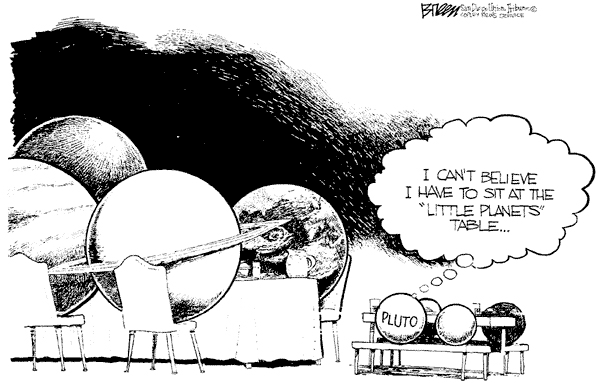Ruth Patrick Science Education Center Observatory
Solar System Series - Pluto
The Pluto cache is part of the solar system cache series that forms an immersive, scaled model of our solar system in the Central Savannah River Area (CSRA). The 5-meter (16.4-feet) dome of the Ruth Patrick Science Education Center (RPSEC) Observatory represents the diameter of the Sun known as Sol. The distance from the observatory to this cache is just over 13 miles, which is the average distance of the orbit of Pluto around the Sun. The geocache itself is the size of an ammo can with an image of Pluto attached to the outside. The image of Pluto is scaled to the proper size if the Sun was 5 meters in diameter.
The cache is located at the Old Academy of Richmond County, and the administration there granted permission for placement. You are welcome to park in the parking lot adjacent to the building or in designated parking spaces along Telfair Street. Pluto's orbit is a bit eccentric compared to the other planets closer to the Sun. It makes it more difficult to discover, and partially why it was not discovered until the 20th Century. This cache follows the same theme, so use your geosenses. There is a spoiler in the hint. While the cache is available 24/7, it is recommended to search for the cache during daylight hours.
Is Pluto a planet? That is a question often asked since the International Astronomical Union (IAU) reclassified this solar system object on 8/24/2006. At the time there were thoughts that Pluto was demoted or kicked out of the club, so to speak. However, an appropriate response is that Pluto is still a planet. There are three types of planets in the Solar System: Terrestrial Planets, Gas Giant Planets and Dwarf Planets. Pluto was the first planet placed in the newest Dwarf Planet category. People can probably name the Terrestrial and Gas Giant Planets. Besides Pluto, most people do not know of the other Dwarf Planets.
- Terrestrial Planets: Mercury, Venus, Earth, Mars
- Gas Giant Planets: Jupiter, Saturn, Uranus, Neptune
- Dwarf Planets: Ceres, Pluto, Haumea, Makemake, Eris (Listed in order from the Sun.)
Pluto was not the first planet to be reclassified when scientists learned of other objects in the same area. Ceres (pronounced cer'-ez) was discovered in 1801 where a planet was expected to be found. It was originally classified as a planet and remained so until the early 1850s when a number of other objects were discovered in the same region of space. At that time, Ceres was reclassified as an asteroid. It was reclassified again on 9/17/2006 as a dwarf planet. (A cache and more information about Ceres can be found at the link below.) In summary, Yes, Pluto is a planet. It is in the special category of Dwarf Planet, but is still a planet.
Pluto Facts:
- Discovered February 18th, 1930 by Clyde Tombaugh at the Lowell Observatory
- From 1979 - 1999 Pluto was closer to the Sun than Neptune.
- Pluto has five moons: Charon, Hydra, Nix, Kerberos and Styx.
- Pluto is smaller than a number of moons in the solar system: Earth's moon- Moon; Jupiter's moons- Ganymede, Calisto, Io, Europa; Saturn's moon- Titan; Neptune's moon- Triton.
- First visitor from Planet Earth - New Horizons Spacecraft launched 1/19/2006, closest encounter with Pluto 7/14/2015
- Pluto's name was proposed by Venetia Burney an eleven-year-old schoolgirl from Oxford, England.
- Mickey Mouse's friend Pluto the dog was named after "Planet" Pluto in 1930.
| Pluto Distances with Sun Diameter = 5 m. |
|
Diameter cm
|
Diameter in
|
Orbit km
|
Orbit mi
|
|
0.83
|
0.33
|
21.23
|
13.19
|



Be sure to obtain the code from the cache container in order to find the final Sun cache location (to be released in the future).
 All First Day Finders (FDF) receive a FDF Award Card.
All First Day Finders (FDF) receive a FDF Award Card.
Congratulations to Joint Cache Force 6, Ollie46 and Tombstone! who sought and were FTF Pluto!
RPSEC Solar System Series:
- RPSEC Mercury - http://coord.info/GC3HQQH
- RPSEC Venus - http://coord.info/GC3JGQ4
- RPSEC Earth - http://coord.info/GC3V76Q
- RPSEC Mars - http://coord.info/GC41QMY
- RPSEC Dwarf Planet Ceres - http://coord.info/GC4342F
- RPSEC Jupiter - http://coord.info/GC49K1F
- RPSEC Saturn - http://coord.info/GC532M6
- RPSEC Uranus - http://coord.info/GC5FFXH
- RPSEC Neptune - http://coord.info/GC5QGBB
- RPSEC Dwarf Planet Pluto - http://coord.info/GC63TR7
- RPSEC Dwarf Planet Haumea - http://coord.info/GC6BXJ4
- RPSEC Dwarf Planet Makemake - http://coord.info/GC6F1RZ
- RPSEC Dwarf Planet Eris - http://coord.info/GC6HVTA
- RPSEC Sun - https://coord.info/GC6VW9W - get the cache codes from the first 13 Solar System Series caches to find the Sun.
Solar System in One Day Honor Roll. Find all of the above caches in one day and be included in the honor roll located on the RPSEC Sun page.
- RPSEC Ultima Thule - http://coord.info/GC81EPX